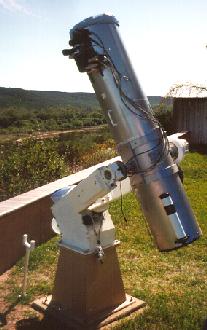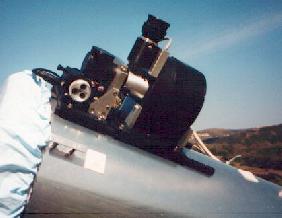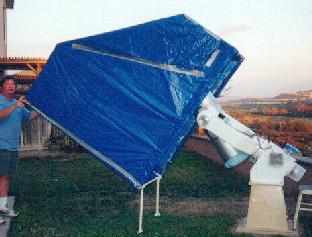


The current telescope uses an F/6 10" mirror masked to 245 mm (9.65") to protect the edge from the protecting cover and to eliminate any possible turned edge. The site overlooks a wide, shallow valley that connects to the Pacific Ocean about 10 km away, so the seeing is often very good. I designed and executed all of the telescope optical assembly. The 12" OD aluminum tubing has rolled ends, increasing the rigidity. I covered the inside of the aluminum tube with cork, then covered with black flocking paper. The exterior is left bare aluminum (with corresponding low thermal emissivity), preventing condensation on even wet nights. Between observing sessions, a close-fitting cover is placed on top of the primary mirror to keep it clean. A small DC fan pulls air through the rear of the tube to equalize the air temperature early in the evening. The tube was cut in approximately two equal lengths, with flanges to connect the two. Dowel pins allow easy rotation of the tube in 90 degree increments, so the eyepiece can be at a more convenient location. The top half of the telescope can be brought indoors for maintenance, while the bottom portion is semi-permanently attached to the yoke. I picked a Novak secondary holder, along with a Crayford focuser from JMI. Rails along the side of the tube, shown below, support the AO-2 adaptive optics system (or the F/15 configuration shown) and the SBIG ST-7E camera and CFW-8 color filter wheel. The rails allow changing the configuration and eliminate the instability which would result from having all of the optics perpendicular to the Newtonian tube. The CCD camera has a custom flip mirror and reticle eyepiece to focus the camera at very high magnifications. It has been calibrated to fall within about 0.03 mm of the focal planes, well within the (F/#)^2 micron focusing tolerance of the large F/# beams used with this telescope.

I modified the focus controller to move in small steps instead of a continuous motion. This simplifies remote operation where a dial indicator cannot be read. A thermometer in thermal contact with the aluminum telescope tube provides a remote readout, so whenever the temperature changes by a certain amount, a single pulse on the focus control corrects the focus by a known amount.
The telescope cover is a plastic tarp held in place over a PVC pipe frame. By simply rotating the cover about its hinge, the telescope is operational in seconds. It keeps the telescope clean and dry, and has survived several years without damage. I have replaced the tarp every few years.

The yoke mount was designed to be as smooth and accurate as possible, as well as large enough to allow an upgrade to a 16" telescope. Although adaptive optics can reduce image motion, the smallest possible amount of initial motion will usually result in higher quality images. The DEC and RA shafts use 2" stainless steel, and tapered roller bearings are placed as far apart as possible. A 9" Byers worm gear runs the RA axis, and a 7" runs the DEC axis. One unusual feature of this 10" telescope is that the maximum declination is about 60 degrees. Since the primary purpose is high resolution imaging, looking any higher would require looking over my house, a pointless exercise. Very few bright planetary nebulae have higher declinations, and shortening the yoke arms makes a more compact and sturdy mount. The mount is bolted to a short steel pier based in concrete. The pier and mount are hollow, with the remote cables routed through the base. The current polar alignment causes DEC and RA drift less than 5 arcsec per hour. Mechanical image motion is damped in less than a second.
The drive electronics are a custom design with permanent periodic error correction based on varying the drive velocity to provide jump-free motion. It also incorporates slow tracking in the DEC axis and RA axes (to follow the planets, up to 100 arcsec/hour). The periodic error correction, along with automatic drift correction, works to reduce image motion to about 2 arcsec RMS for periods of hours, with no guiding required. The control console is indoors, using about 80 feet of cables. The computer for the SBIG camera is also indoors.
All text and images are owned by Stellar Products, 1992-2003. Any use by others without permission of Stellar Products is prohibited.
Links to other Stellar Products pages: